Generally speaking, predatory animals are very insensitive creatures, to say the least. Take a wolf, for example. It will pounce upon a young deer and begin to make a meal out of it. The poor wretch may be writhing and moaning in pain, but the wolf is unfazed. He callously goes about his flesh-eating business, impervious to the cries of its prey.
As we shall see, this quality is not limited to the animal kingdom. All too often, it is even found in man himself.
The Darker Side
This idea is borne out by the Mishnah in Avos (3:2), which states:
“R’ Chanina S’gan Hakohanim says: Pray for the welfare of the government. If not for the fear of government, people would swallow each other alive.”
On its most elementary level, the Mishnah seems to be underscoring the importance of a stable government. Whatever one might want to say about a particular form of government or a specific ruling body, it does fulfill an essential function: keeping people in check. When anarchy reigns, and there is no authority to whom one must answer, people’s worst instincts come to the fore. Pillaging, crime, and general chaos become the order of the day. Only when a fear of retribution prevails can order be maintained.
However, a closer look reveals that an even deeper lesson is contained herein. The Mishnah did not state that the absence of a fear of government would cause people to simply turn against one another or harm their fellow. The description was very specific: they will swallow each other alive. R’ Yeruchem Levovitz explains (Da’as Chochmah U’mussar, vol. 1, sec. 12) that this is the same attribute found in carnivorous animals as described above: to inflict torment on another for personal benefit, even while the victim is still alive and experiencing pain. The Crusaders, the Cossacks, the Nazis – none were deterred or bothered by the intolerable persecution they visited even upon little children. On the contrary, they reveled in it.
How could human beings sink to such levels of depravity, exceeding even wild beasts in their viciousness?
The answer may lie in a familiar phrase in this week’s parshah.
Before creating man, Hashem uttered the words “Na’aseh Odom,” “Let Us make man” (Bereishis 1:26). The commentators grapple with the fact that the plural form is used in this statement. Seemingly, it is entirely out of place. Let Us make man? There is only one Hashem, of course! Who is “Us?”
Rashi quotes a well-known explanation from Chazal, who recognize that a remarkable ethical lesson is being imparted here. Obviously, Hashem could – and did – create man and everything else single-handedly. However, He wished to demonstrate the importance of humility, where even those who are great should take counsel from their underlings. Therefore, Hashem ”conferred” with the angels prior to fashioning man, and it was to them that he addressed the statement ”Let Us make man.”
There is, however, an alternate explanation offered elsewhere by Chazal, which sheds light on man’s potentially destructive nature as mentioned above. R’ Elchonon Wasserman (Kovetz Ma’amarim) quotes the Zohar, which states that the “Let Us make man” directive was addressed to the creatures of the world. Hashem was instructing all of Creation to “give of themselves” toward the greater project of the creation of man. In other words, the innate characteristics and properties of the various creatures of the world made up the “ingredients” of the creature known as man.
It should now be easier to understand how it is possible for individuals and nations to sink to the nethermost levels of wickedness and sheer violence, as we have witnessed throughout the ages. Not that such behavior is excusable, of course, but at least we can trace the source. As R’ Elchonon explains, within every individual is a “piece” of lion, wolf, snake, etc. Left uncurbed, a person could become the most vicious and destructive creature in the world.
The Big Choice
If we were to stop at this point, the picture would look bleak indeed. It almost appears as if man is perfectly positioned to behave like a ferocious monster.
But, of course, this is only half of the story. For Hashem has imbued the opposite component within each person as well – namely, the neshamah, the G-dly spirit that is the true essence of every individual.
“Hashem has made man to be straight; it is they who have sought out various designs” (Koheles 7:29). As the Ramban at the end of this week’s parshah explains (Bereishis 6:3), if a person capitalizes on the spiritual potential of his soul, he can rise to the level of the angels. It is only when he allows himself to be led by the animalistic inclinations of his physical attributes that he becomes distracted from the proper path. By doing so, he ends up taking the “down” escalator, instead of going “up.”
Most recently, the Nazis (may their memory be erased) demonstrated to the world to what levels man can descend if he merely follows his innate “killer” instincts. For the most part, an entire continent’s-worth of people were transformed into walking, bloodthirsty demons. Throughout the centuries, however, the Jewish people have shown the world how things appear on the opposite end of the spectrum. A Vilna Gaon, a Chofetz Chaim – this is what a person can become by developing his spiritual energies. As we continue to follow in the path of Torah and mitzvos, we too, can provide an example of the angelic creatures which man can resemble, if he so chooses.
Did you ever notice how parents react to the exploits of their toddlers? Let us say, for example, that on the way to the babysitter, the young child – of his own accord – picks up his coat and even puts it on. Most likely, his parents will be beside themselves with joy. “Hooray!” they might exclaim, and clap enthusiastically over the little one’s display of prowess and acumen.
But if an adult was to do the exact same thing – put on his coat before going outside – no one would even bat an eyelash. And for good reason. After all, such is expected of a grown-up; he receives no special commendations for performing basic tasks.
Congratulations for Compliance
And yet, there seems to exist an example in this week’s parshah of an individual who is given accolades for what appears to be fairly standard behavior. The parshah opens with some details regarding the lighting of the Menorah in the Sanctuary: וַיְדַבֵּר ד’ אֶל־מֹשֶׁה לֵּאמֹר, דַּבֵּר אֶל־אַהֲרֹן וְאָמַרְתָּ אֵלָיו בְּהַעֲלֹתְךָ אֶת־הַנֵּרֹת אֶל־מוּל פְּנֵי הַמְּנוֹרָה יָאִירוּ שִׁבְעַת הַנֵּרוֹת – “And Hashem spoke to Moshe saying: Speak to Aharon and say to him: When you light the lamps, the seven lamps should illuminate toward the face of the Menorah” (Bamidbar 8:3). The directive refers to the arrangement of the lighting. The Menorah of the Temple is comprised of seven branches: three on either side of the central stem (the term “p’nei hamenorah” in this passuk refers to this central lamp). Aharon was thus instructed to direct the lights of the branches such that they should face toward the central lamp.
The Torah proceeds to report that Aharon adhered to the command: “Vaya’as kein Aharon – Aharon acted accordingly” (ibid. v. 3). Commenting on the need for the Torah to provide this information, Rashi states: לְהַגִיד שְׁבָחוֹ שֶׁל אַהֲרֹן שֶׁלֹא שִׁנָה – “This relates the praise of Aharon, (informing us) that he did not deviate (from the instructions).”
Aharon, of course, was a righteous individual of towering spiritual stature. There is no lack of his attributes to hold up and applaud. For example, we find that Chazal exhort us to follow the example of his sterling character. As the Mishnah states (Avos 1:12):
הֱוֵי מִתַּלְמִידָיו שֶׁל אַהֲרֹן, אוֹהֵב שָׁלוֹם וְרוֹדֵף שָׁלוֹם, אוֹהֵב אֶת הַבְּרִיּוֹת וּמְקָרְבָן לַתּוֹרָה.
“Be from the disciples of Aharon: Loving peace and pursuing peace, loving people and drawing them close to Torah.”
So it certainly seems surprising that, of all potential qualities, the passuk here chose to emphasize this particular item. Is it really so extraordinary that Aharon lit the Menorah in accordance with Hashem’s directive? Would we have thought otherwise? Why, then, is such praise extended to Aharon for merely doing as he was told?
The truth is that many commentators grapple with this issue, providing any number of explanations. (In fact, this was the subject of a Mishnas Chayim article of a previous year [5768], where the innovative approach of the Maharil Diskin was advanced.) Due to space constraints, we will suffice here by presenting the novel approach cited by R’ Zalman Sorotzkin in his Torah commentary Oznayim LaTorah.
Pinpoint Location
What, exactly, did the instructions entail? As stated above, the matter seems to involve the directional placement of the wicks within the lamps; on either side of the central stem were three lamps, the flames of which should each face toward the center. R’ Sorotzkin points out, however, that the wording of the passuk would seem to imply that there is more to it than that. According to this arrangement, there are really only six lamps that are affected (three on each side of the central one); why, then, does the passuk include all seven lamps in the directive: אֶל־מוּל פְּנֵי הַמְּנוֹרָה יָאִירוּ שִׁבְעַת הַנֵּרוֹת ? This would seem to imply that the entirety of the Menorah is involved in the directional arrangement of the lamps.
It must be, then, that these instructions issued to Aharon entail much more than the placement of the wicks towards the central lamp. R’ Sorotzkin explains that the additional requirement relates to a classic Kabbalistic concept that speaks of a “Mikdash Shel Ma’alah – Upper Sanctuary.” Even while the Beis Hamikdash (Holy Temple) stood in Yerushalayim, there was another, corresponding Mikdash in the Heavens Above. Thus, the directive regarding the lighting of the Menorah requires that the flames of its lamps – all seven of them – should face toward the exact celestial “location” of the Menorah in the Heavenly Spheres.
Now, truth be told, this did not present such a challenge for the officiators in the Beis Hamikdash of Yerushalayim. That was a permanent structure, which was situated here on earth directly below the “location” of the Mikdash Shel Ma’alah in Heaven. As such, the Menorah’s lights were basically fixed in position right where they should be, facing the proper Celestial point.
It was in the times of the portable Mishkan (Tabernacle) that an issue arose. Here, the terrestrial Sanctuary was constantly on the move, being dismantled and transported from one place and erected in another. As such, the kohein (priest) who would light the Menorah in the Mishkan could not simply rely on the fact that the flames would automatically face the proper Celestial location. Rather, he had to be able to discern – from wherever he stood on earth – exactly where the Menorah in Heaven was situated. Obviously, this could not be achieved by any ordinary person, as it required an intimate knowledge and familiarity with the Celestial spheres. As such, only an individual whose soul was extremely refined and pristine, whose essence was lofty and elevated, could possess such spiritual sensitivities to pinpoint this location.
This, explains R’ Sorotzkin, was the essence of the praise accorded to Aharon. He was not commended simply for following instructions, but for the fact that he was capable of carrying them out. In other words, his ability to successfully execute this service indicates his lofty spiritual stature; for it was only because of his exalted level that he could so precisely fulfill his task.









